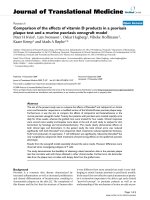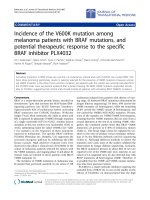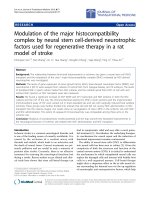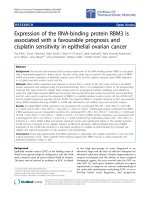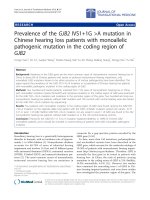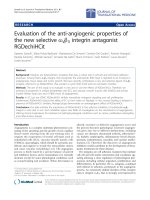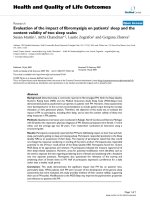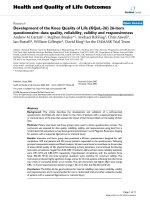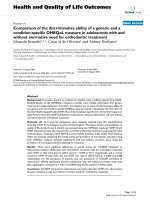báo cáo hóa học:" Determinants of agreement between self-reported and parent-assessed quality of life for children in Germany - Results of the German Health Interview and Examination Survey for Children and Adolescents (KiGGS)" pptx
Bạn đang xem bản rút gọn của tài liệu. Xem và tải ngay bản đầy đủ của tài liệu tại đây (231.12 KB, 24 trang )
This Provisional PDF corresponds to the article as it appeared upon acceptance. Fully formatted
PDF and full text (HTML) versions will be made available soon.
Determinants of agreement between self-reported and parent-assessed quality
of life for children in Germany - Results of the German Health Interview and
Examination Survey for Children and Adolescents (KiGGS)
Health and Quality of Life Outcomes 2011, 9:102 doi:10.1186/1477-7525-9-102
Ute Ellert ()
Ulrike Ravens-Sieberer ()
Michael Erhart ()
Barbel-Maria Kurth ()
ISSN 1477-7525
Article type Research
Submission date 23 March 2011
Acceptance date 23 November 2011
Publication date 23 November 2011
Article URL />This peer-reviewed article was published immediately upon acceptance. It can be downloaded,
printed and distributed freely for any purposes (see copyright notice below).
Articles in HQLO are listed in PubMed and archived at PubMed Central.
For information about publishing your research in HQLO or any BioMed Central journal, go to
/>For information about other BioMed Central publications go to
/>Health and Quality of Life
Outcomes
© 2011 Ellert et al. ; licensee BioMed Central Ltd.
This is an open access article distributed under the terms of the Creative Commons Attribution License ( />which permits unrestricted use, distribution, and reproduction in any medium, provided the original work is properly cited.
- 1 -
Determinants of agreement between self-reported and
parent-assessed quality of life for children in Germany
- Results of the German Health Interview and
Examination Survey for Children and Adolescents
(KiGGS)
Ute Ellert
1
*
§
, Ulrike Ravens-Sieberer
2
*, Michael Erhart
2
*, Bärbel-Maria Kurth
1
*
1
Department of Health Reporting, Robert Koch Institute, Seestr. 10, 13353 Berlin,
Germany
2
Child Public
Health, Department of Child and Adolescent Psychiatry, Psychotherapy
and Psychosomatics, University Medical Centre Hamburg-Eppendorf, Martinistr. 52,
20246 Hamburg, Germany.
*These authors contributed equally to this work
§
Corresponding author
Email addresses:
UE:
URS:
ME:
BMK:
- 2 -
Abstract
Background
The aim of this study is to quantify the level of agreement between self-reporting and
proxy-assessment of children’s health-related quality of life using KINDL-R in a
large population based study in Germany and to identify factors which are associated
with agreement.
Methods
The German Health Interview and Examination Survey for Children and Adolescents
included the KINDL-R questionnaire on health-related quality of life. 6388 children
and adolescents filled in the questionnaire while their parents answered the proxy
version. Means and standard deviation for the self- and proxy ratings, and also the
Pearson und Intra-Class correlation coefficients for the absolute agreement were
calculated. The relationship between other variables and parent-child agreement were
determined by means of logistic regression.
Results
In the ‘Physical’, ‘Self-esteem’ and ‘School’ dimension and for the ‘Total’ score, the
parents significantly overestimated the quality of life of their child. In contrast, the
quality of life of the children in the dimensions ‘Psychological well-being’ and
‘Family’ were considerably underestimated by the parents. The proportion of parent-
child ratings in agreement (difference < 0.5 standard deviations) ranges from 34.9%
for the ‘Self-esteem’ scale to 51.9% in the ‘Psychological’ scale. The most important
factor explaining parents rating was the level of the child’s self-assessment followed
by the parent’s assessment of the subjective health, or reported emotional
abnormalities.
Conclusions
Our study shows that parental reports cannot adequately replace self-assessment for
11-17 year olds. In view of the different underlying perspectives, the parental
assessments should where possible only be regarded as providing supplementary
information.
- 3 -
Background
In recent years, increasing importance has been attached to health-related quality of
life (HRQoL) in child and adolescent medicine. The measurement of HRQoL of
children and adolescents is meanwhile at least as important as for adults in clinical
and public health studies [1]. The focus of interest is on the perception and evaluation
of an individual’s own life from a subjective perspective. For this reason, self-
reporting is generally preferable to proxy assessments. However, this is only possible
for children and adolescents who are capable of providing the necessary information
as a result of their age, their cognitive development, and their state of health.
Solans et al. [2] identified 30 generic and 64 disease-specific instruments to register
the quality of life of children and adolescents. Some generic as well as some disease-
specific instruments draw only on the self-reporting of the children and adolescents. A
number of instruments (43% of generic instruments and 30% of disease-specific ones)
have versions both for parental (proxy) assessment and self-assessment. Some
methods are based solely on information provided by parents.
There is considerable disagreement about the value of external assessments (by
teachers, experts, parents). It has been argued that children/adolescents may operate
within different reference systems and thus differ from adults in their understanding
of HRQoL [3]. While parents can easily identify behavioural problems, this may not
be the case with emotional problems such as sadness or tension [4]. Parents often lack
first-hand information, for example, regarding the school experience or the social
interactions of their children with friends. On the other hand, parent proxy reports
could be also regarded as providing important complementary information about
children’s QoL [5]. It has been argued that discrepancies between self and proxy
reports could validly reflect each respondent’s perspective and not merely inaccuracy
or bias [6].
A number of studies and reviews in recent years have compared self-assessment and
information provided by proxy [3]. Whereas parents as a rule overestimate their
healthy child’s health-related quality of life [7-10], parents of chronically ill children
tend to rate their health-related quality of life lower than the children do themselves.
This has been shown for children with cerebral palsy [11] and for children with cancer
- 4 -
[10, 12]. In contrast, Chang et al. found that parents overestimated the health-related
quality of life of their children with cancer [13, 14].
Various factors influence the extent of agreement or difference between the
assessments of parents and children, they differ depending on the direction of the
deviation and they affect different dimensions of the quality of life [11, 13, 15]. The
level of child/parent agreement also depends on the level of the quality of life [7, 15].
In a study of 500 children with cerebral palsy aged 8 to 12 years in seven European
countries, White-Koning et al. [11] found that high levels of parental stress were more
likely to be associated with an overestimation of the child’s quality of life, whereas
parents were likely to underestimate the quality of life of children with severe pain. In
some studies, associations were found between the self-assessments of the quality of
life and the sex [7, 13] or the age of the children [7, 9, 11, 13], and between proxy
assessments and the age of the parents [12] or their level of education [11, 12].
Intercultural differences were found in a Europe-wide study in the extent of the
agreement between assessments by proxies and children [15].
As part of the German Health Interview and Examination Survey for Children and
Adolescents (KiGGS) of the Robert Koch Institute, the children self-report- and the
parent proxy-report version of the KINDL-R quality of life instrument was employed.
The psychometric properties of both versions had been examined and reported in a
companion paper [16]. Overall both versions were found to enable a reliable and valid
assessment of children’s quality of life. However some differences were seen [16].
The aim of the present paper thus is to further examine the origin of these differences.
Our first aim here is to quantify the level of agreement between children self-report
and parent proxy reported quality of life. Second, we want to identify
sociodemografic-, socioeconomic- and health-status- factors which are associated
with a better or poorer agreement.
- 5 -
Methods
Design and sample
The German Health Interview and Examination Survey for Children and Adolescents
(KiGGS) was carried out by the Robert Koch Institute from 2003 to 2006. Details of
the preparation and implementation of this health survey are described elsewhere [17-
20]. The survey involved a total of 17 641 children and adolescents aged 0-17 years.
There was a 66.6% rate of participation. Since key socio-demographic and health-
related characteristics for children and parents could be registered for two-thirds of
the non-respondents, basic information is available for 89% of the target population
and could be compared between responders and non-responders
. The response
analyses are described in detail elsewhere [18, 21]. The study was approved by the
Charité – Universitätsmedizin Berlin ethics committee and the Federal Office for the
Protection of Data.
For this evaluation, we used data from 6 388 children and adolescents aged 11-17
years with complete parent – child pairs, because only for the 11- 17 years olds, the
KINDL-R questionnaire is presented in parallel for self-reporting and proxy
assessment.
The KINDL-R
KiGGS included the KINDL-R questionnaire on health-related quality of life [22],
which has previously been tested psychometrically and clinically in epidemiological
investigations as a quality of life instrument [16, 23-25]. In contrast to most quality of
life instruments for minors, which had originally been developed in English and then
translated into German in a methodologically laborious process, the revised KINDL-R
questionnaire is a German-language instrument which can be used with both clinical
populations and also healthy children and adolescents. The KINDL-R is a
questionnaire with 24 items, covering the following six dimensions of the quality of
life over the past week: ‘Physical’, ‘Psychological’ , ‘Self-esteem’, ‘Family’ ,
‘Friends’ and ‘School’ , available in 23 languages. The time needed to complete
differs between 5 and 15 minutes according child's age. The mean time is 15 minutes.
Both a self-assessment KINDL-R questionnaire and a proxy version (accompanying
parents or caregivers) are available. Answers can be given in five categories (never,
seldom, sometimes, often, always). It is possible to calculate a ‘Total’ score for the
- 6 -
health-related quality of life from all 24 items. All measurements are scored on a scale
from 0-100 points, and the higher the value then the better the quality of life. For the
11- 17 years olds, the KINDL-R questionnaire is presented in parallel for self-
reporting and proxy assessment. Norms for Germany are available in [26].
Associated factors
Factors which could potentially be influential were: age and sex of child, the proxy
(mother, father, mother and father, or another person), region of residence (former
East or West Germany), migration background, social status of the family, child rated
family climate, indications of mental abnormalities by means of the Strengths and
Difficulties Questionnaire SDQ (normal, borderline, abnormal), the parental
assessment of the child’s state of health (very good/ good, medium, or poor/ very
poor), a need for increased care as assessed by the parent according to the screener
for children with special health care needs (CSHCN) (yes/ no), any pain in the last
three month, and the value of the self-assessed quality of life.
Information on covariates was obtained from self-administered questionnaires from
parents and also from the children themselves (in children aged 11 years and older).
The 10 federal states of the Federal Republic of Germany before reunification were
defined as West Germany, whereas the five new federal states covering the region of
the former German Democratic Republic and the federal state of Berlin were defined
as East Germany. Data on parents’ income, occupational status, and educational and
occupational qualification from the parental questionnaire were used to quantify the
socio-economic status (SES) of the children and adolescents as low, middle or high.
Each of the three components was rated with a point system (1-7 points). The sum
was calculated and categorised into the following groups: (1) low SES (3-8 points);
(2) medium SES (9-14 points); and (3) high SES (15-21 points) [20]. Participants
were referred to as migrants if they had immigrated themselves and had at least one
parent who was not born in Germany or was of non-German nationality, or if both
parents had immigrated or were of non-German nationality [27]. Family protecting
factors were obtained using a shortened form of nine items of the family climate scale
[28].The parents filled in a questionnaire including a screening measure of emotional
and behavioural problems in their children (Strengths and Difficulties Questionnaire
SDQ). The SDQ contains 25 items assessing internalising and externalising problems
on four subscales (emotional problems, behavioural problems, inattention /
- 7 -
hyperactivity, peer problems) and, as strengths, prosocial behaviour on one subscale.
The four problem subscales are summed up to a total difficulties score [29]. The
CSHCN screener includes five items each subsuming one or two filter questions. The
items refer to ‘‘use of prescribed medicine’’, ‘‘above average use of or need for
medical, mental, or educational services’’, ‘‘functional limitations in comparison to
other children of same age’’, ‘‘use of or need of special therapies’’ and ‘‘treatment or
counselling for emotional or developmental problems’’ [30]. Information on pain in
the last three month was obtained from the children themselves [31].
Statistical analysis
The statistical evaluation was carried out using SPSS Version 14.0. In order to take
account of the grouped data structure the 95% confidence interval were determined
with the SPSS-14 procedure for complex samples. Weighting factors were introduced
to correct for unequal sampling probabilities and to ensure that the survey population
was representative of the national child population.
Agreement was evaluated at the individual level as well as at the group level. For each
quality of life dimension, we calculated the mean and standard deviation for the self-
and proxy ratings, and also the Pearson und Intra-Class correlation coefficients for the
absolute agreement. The mean difference (child value minus parent value) was
determined and standardised by dividing the value by the mean standard deviation of
both scores (effect size) [32], thus the direction of disagreement between the self- and
proxy ratings could be specified. As an additional indicator of agreement, the mean of
the absolute value of the difference between values for children and parents was
determined [33].
Since self-report questionnaires are regarded as the primary method of assessing
HRQoL, the self-assessment was arbitrarily set as the reference point. Similar to other
studies [11, 34, 35] and according to the usual definition of a clinically important
difference in the health-related quality of life, self-assessment and parental assessment
were rated as “in agreement” when the absolute difference was less than or equal to
half the standard deviation of the child’s values [36]. This distribution based method
was also recommended in [37]. The standard deviation of the child-self report was
used since this was comparable to the standard deviation in parent’s/proxies’ data
- 8 -
(with higher children’s SD in most scales), our definition of agreement sufficiently
regards the variability of both respondent’s scores. Of the cases which were not in
agreement, we distinguished between those where the parents gave a lower estimate
of the quality of life of their child (underestimation: parent<child) and those where the
parents gave a higher estimate of the quality of life of their child (overestimation:
parent>child).
The relationship between other variables (associated factors) and parent-child
agreement were determined by means of logistic regression.
Results
Sample characteristics
A total of 6388 parent-child pairs were available for the analysis. The answers to the
questionnaire were provided by the mother in a large majority of cases (83.5%).
About a tenth of questionnaires were completed by the father, and in 5% of cases both
parents responded. Further characteristics of the study population can be found in
Table 1.
Self-proxy agreement
In three of the six quality of life dimensions (‘Physical’, ‘Self-esteem’, ‘School’) and
for the ‘Total’ score, the parents significantly overestimated the quality of life of their
child (Table 2). In contrast, the quality of life of the children and adolescents in the
dimensions ‘Psychological well-being’ and ‘Family’ were considerably
underestimated by the parents. ‘Friends’ is the only dimension for which the parental
assessment switches with age between too low and too high. Here the parents gave the
11- 13 year-olds a lower quality of life whereas for the 14 – 17 year-olds they
reported a higher quality of life.
The correlations between the values for parents and children were low to moderate (a
maximum of 0.52 for Pearson and 0.51 ICC). In most quality of life dimensions the
effect size of the mean difference was moderate (<0.5). The effect size was above 0.5
for ‘Self-esteem’, and in the case of the 11- 13 year-olds also for the ‘Family’ scale.
The ‘Self-esteem’ scale also showed the greatest absolute differences.
- 9 -
The proportion of parent-child ratings in agreement (difference < 0.5 SDs) ranges
from 34.9% for the ‘Self-esteem’ scale to 51.8% in the ‘Psychological’ scale (Figure
1). For the ‘Total’ score, 36.7% were in agreement. For three of the six scales
(‘Family’, ‘Psychological’, ‘Friends’), the disagreements between parent and child
were mainly due to parents overestimating their child’s quality of life. This proportion
was largest for the ‘Family’ scale, with 40.7%. In the dimensions ‘Physical’, ‘School’
and ‘Self-esteem’ and in the ‘Total’ score, the proportion of parental overestimations
was larger than the parental underestimation of the quality of life of the children. The
proportion of parents underestimating the quality of life of their child was smallest for
‘Self-esteem’ (17.0%), and in this case the proportion of overestimations was largest
(48.2%).
Multivariate analysis
Tables 3 and 4 show the result of the multivariate analysis to explain the over- or
under-estimation by the parents of their child’s quality of life. The higher the self-
assessed quality of life (child rating), the greater is the probability that the parents will
underestimate the quality of life in all dimensions (Tab. 3). If the parents report
behavioural abnormalities of their child, then for each dimension there is an increased
probability that the parents will underestimate the quality of life. The same applies if
the parents report the state of health of their child not as very good.
Regarding the ‘Physical’ domain of quality of life, the chance of parental
underestimation is lower for boys than girls, whereas for the ‘School’ dimension it is
higher for boys. With increasing age of the children, the parents are less likely to
underestimate their child’s quality of life with respect to Friends; in contrast, the
probability of underestimating in the ‘School’ dimension increases with the age of the
child. Parents with a migration background are more likely to underestimate the
school-related quality of life of their children than parents without a migration
background, whereas in the ‘Family’ dimension the chance of parents underestimating
is lower in migrant families than families without a migration background. If mother
and father respond to the questionnaire together then there is a lower change of
underestimating the quality of life in the sectors ‘Self-esteem’, ‘Friends’ and in the
‘Total’ score than if the mother answers the questions alone.
- 10 -
The higher the self-assessed quality of life, then the less likely it is that the parents
will overestimate the quality of life in all domains (Tab. 3b). If the parents report
behavioural abnormalities of their children, there is a reduced likelihood for each
quality of life dimension that the parents overestimate the quality of life. The same
applies when parents assess the state of health of their child not as very good, except
that in this case the evaluation of the ‘Family’ scale is not influenced.
Regarding the ‘Physical’ dimension and the quality of life with respect to Friends,
there is a greater likelihood of parental overestimation in the case of boys than girls.
With increasing age of the children, the likelihood of parental overestimation of their
child’s quality of life sinks for the ‘School’ dimension, whereas the likelihood of
overestimating the quality of life with respect to Friends increases with the age of the
child. Parents with a migration background are more likely to overestimate the quality
of life of their child in the dimensions ‘Psychological’ , ‘Family’ , ‘Friends’ and in
the ‘Total’ score than parents without a migration background, whereas regarding
‘School’ there is a lower chance of parental overestimation in migrant families than
families without migration background. If mother and father together or a third-person
answers the questionnaire as proxy, then there is a greater chance that the
‘Psychological’ dimension of quality of life will be overestimated.
Discussion
The purpose of the present paper was to compare self-assessment and proxy
assessment by parents of the quality of life of children and adolescents in a
representative German survey. In summary we found low to moderate correlations
between the values for parents and children. Inmost quality of life dimensions the
effect size of the mean difference between parents and children score was moderate.
Children’s gender, emotional-and behavioural problems, family climate, migration
status and parental gender were associated with patterns of disagreement between
child and parent scores in most KINDL scales. From our results it can be concluded
that boys and migrants and especially boys with migrant status constitute a group at
higher risk for parental non-recognition of a decreased Quality of life.
In accordance with the findings of other studies, the agreement between the
assessments of parents and their children was relatively small [10, 11]. However, the
- 11 -
correlation coefficients for the KINDLR in this study and also in the study by Jozefiak
et al. [8] were higher than for the PedsQL [9], and they are comparable with the
values of KIDSCREEN [15] or TACQOL [7] for healthy children. As in other studies,
we found that the agreement for daughters is greater than for sons [15], and for
adolescents is greater than for children [8, 15] (Tab.2). In contrast, Creemens et al. [9]
found greater agreement for children than for adolescents.
There are considerable differences, depending on the dimension of quality of life
considered. The greatest agreement (51.8%) was reached for the ‘Psychological’
scale, although the correlation coefficients (Pearson and ICC) are only about 0.32. As
far as differences are concerned, parental underestimation of the quality of life in this
dimension was occurred more often than overestimation. Least comparable were
parent and child assessment of ‘Self-esteem’. Here only about a third of parents
agreed with the assessment of their child. The greatest proportion of parents (48.2%)
overestimated the quality of life of their child in this dimension. Concerning ‘Family’,
the parental assessment of the quality of life was most often too low. In contrast to
other studies [4, 8] we did not find the greatest agreement for the ‘Physical’ scale. A
review of the items it contains shows that this KINDL scale also focuses more on
subjective perceptions, “ I felt ill”, “ I had a headache or tummy-ache”, “ I was
tired and worn-out” “I felt strong and full of energy”. Parents may not have any direct
access to these individual insights. The ‘Physical’ scale of other instruments may ask
for more externally visible signs of behaviour which can also be directly observed by
the parents. For example most of the PedsQL items ask directly visible activities e.g.
“hard to walk more than one block”, “hard to run”, hard to do sports activities” “hard
to lift something heavy” “hard to take bath/shower”. “trouble getting along with other
teens”, “other teens tease”, “cannot do things other teens can do”, “hard to pay
attention in class”, “forgot things”, “trouble with schoolwork”, “miss school”. Only
the 5 emotional items (”feel afraid”, “feel sad”, etc) are less visible for parents (as is
the case with the KINDL-R items).
As described in other studies [11, 13, 15], we also found a difference in the extent to
which factors influence the agreement or disagreement, depending on the dimension
of quality of life considered. The most important influence was the level of the child’s
self-assessment followed by the parent’s assessment of the subjective health, or
- 12 -
reported emotional abnormalities. If there were emotional abnormalities and /or the
state of health of the child was reported to be moderate, poor or very poor, then the
parents tended to underestimate the quality of life of these children. This could be due
to the so-called Response-Shift phenomenon. Children with chronic health problems
may have developed improved strategies for coping with them. At the same time,
these children may also have adapted their internal assessment standards to their state
of health and after some time may report a higher quality of life than an observer such
as their parents would expect [38, 39].
Parents with a lower socio-economic status tended to underestimate the quality of life
of their children less frequently with respect to Friends. It goes beyond the scope of
this study to consider whether parents in socio-economically disadvantaged families
come to accept social disadvantages and limitations as inevitable [40] and are for this
reason less likely to underestimate the quality of life of their children with respect to
Friends.
Additional analyses reported in a companion paper [16] showed the parent reports
were internally more consistent than the children reports. However both versions were
found to enable a valid and reliable assessment. From a theoretical point of view and
for the sake of presenting a clear argumentation we still would consider the subjective
self reports as being more valid than the parental reports.
The study was based on a national representative sample of the general population of
children and adolescents in Germany. Thus it is likely that the results are
generalizable to specific populations encompassed by our sample. Clearly our
findings cannot be generalized to institutionalized child populations, or child
populations with strong mental retardation.
It is not possible to conclude how far these results can be generalized to other generic
quality of life scales. Even in the case of similar scale and item content the exact
wording of a particular item might lead to responder specific response behaviour that
cannot be predicted from our findings.
- 13 -
This study is subject to methodological limitations. A basic limitation is that the
analysis of a cross-sectional dataset excludes the possibility of a causal interpretation
of differences between parents and children. A further limitation lies in the statistical
analysis using a categorisation of the differences between parents and children into
three classes (overestimation, underestimation, agreement). This means that
psychometric information can be lost. As a result our analyses could tend to
underestimate the strength of the effects being analysed. On the other hand, our
evaluation strategy does make it possible to concentrate on practically important
differences between parents and their children. An advantage of the chosen approach
is that the direction of parent-child-disagreement can be differentiated, which is part
of the key message of our analyses. The role of parental stress was beyond the scope
of this investigation. In an additional study module on mental health – the BELLA
Study [41], details of parental stress were also considered for a sub-sample.
The strengths of the study lie in the fact that, for the first time, health-related quality
of life has been studied in a large sample of 11-17 year old children and adolescents,
representative of the entire population in Germany. In particular the explicit
consideration of families with a migration background can provide valuable insights.
Conclusions
KiGGS shows that parental reports cannot adequately replace self-assessment for 11-
17 year olds. In view of the different underlying perspectives, the parental
assessments should where possible only be regarded as providing supplementary
information. Where there is no self-assessment, due to ill-health or cognitive
limitations, then the different perspectives represent a problem. Our findings can help
with the interpretation of isolated parental assessments.
- 14 -
Competing interests
The authors declare that there are no competing interests.
Authors' contributions
UE has conducted the statistical analyses and has conceptualised and written the
manuscript. BK and URS were the principal investigators of the study and have
advised the writing of the manuscript and have revised the paper. ME has assisted in
the statistical analyses and has revised the manuscript. All authors have read and
approved the final manuscript.
Acknowledgements
The German Health Interview and Examination Survey for Children and Adolescents
(KiGGS) was funded by the German Ministry of Health, the Ministry of Education
and Research and the Robert Koch Institute.
- 15 -
References
1. Ravens-Sieberer U, Erhart M, Wille N, Wetzel R, Nickel J, Bullinger M:
Generic health-related quality-of-life assessment in children and
adolescents: methodological considerations. Pharmacoeconomics 2006,
24:1199-1220.
2. Solans M, Pane S, Estrada MD, Serra-Sutton V, Berra S, Herdman M, Alonso
J, Rajmil L: Health-related quality of life measurement in children and
adolescents: a systematic review of generic and disease-specific
instruments. Value Health 2008, 11:742-764.
3. Eiser C, Morse R: Can parents rate their child's health-related quality of
life? Results of a systematic review. Qual Life Res 2001, 10:347-357.
4. Guyatt GH, Juniper EF, Griffith LE, Feeny DH, Ferrie PJ: Children and
adult perceptions of childhood asthma. Pediatrics 1997, 99:165-168.
5. De Civita M, Regier D, Alamgir AH, Anis AH, Fitzgerald MJ, Marra CA:
Evaluating health-related quality-of-life studies in paediatric populations:
some conceptual, methodological and developmental considerations and
recent applications. Pharmacoeconomics 2005, 23:659-685.
6. White-Koning M, Arnaud C, Bourdet-Loubere S, Bazex H, Colver A,
Grandjean H: Subjective quality of life in children with intellectual
impairment how can it be assessed? Dev Med Child Neurol 2005, 47:281-
285.
7. Theunissen NC, Vogels TG, Koopman HM, Verrips GH, Zwinderman KA,
Verloove-Vanhorick SP, Wit JM: The proxy problem: child report versus
parent report in health-related quality of life research. Qual Life Res 1998,
7:387-397.
8. Jozefiak T, Larsson B, Wichstrom L, Mattejat F, Ravens-Sieberer U: Quality
of Life as reported by school children and their parents: a cross-sectional
survey. Health Qual Life Outcomes 2008, 6:34.
9. Cremeens J, Eiser C, Blades M: Factors influencing agreement between
child self-report and parent proxy-reports on the Pediatric Quality of Life
Inventory 4.0 (PedsQL) generic core scales. Health Qual Life Outcomes
2006, 4:58.
10. Russell KM, Hudson M, Long A, Phipps S: Assessment of health-related
quality of life in children with cancer: consistency and agreement between
parent and child reports. Cancer 2006, 106:2267-2274.
11. White-Koning M, Arnaud C, Dickinson HO, Thyen U, Beckung E, Fauconnier
J, McManus V, Michelsen SI, Parkes J, Parkinson K, et al: Determinants of
child-parent agreement in quality-of-life reports: a European study of
children with cerebral palsy. Pediatrics 2007, 120:e804-814.
12. Matziou V, Perdikaris P, Feloni D, Moshovi M, Tsoumakas K, Merkouris A:
Cancer in childhood: children's and parents' aspects for quality of life.
Eur J Oncol Nurs 2008, 12:209-216.
13. Yeh CH, Chang CW, Chang PC: Evaluating quality of life in children with
cancer using children's self-reports and parent-proxy reports. Nurs Res
2005, 54:354-362.
14. Chang PC, Yeh CH: Agreement between child self-report and parent
proxy-report to evaluate quality of life in children with cancer.
Psychooncology 2005, 14:125-134.
- 16 -
15. Robitail S, Simeoni MC, Ravens-Sieberer U, Bruil J, Auquier P: Children
proxies' quality-of-life agreement depended on the country using the
European KIDSCREEN-52 questionnaire. J Clin Epidemiol 2007, 60:469-
478.
16. Erhart M, Ellert U, Kurth BM, Ravens-Sieberer U: Measuring adolescents'
HRQoL via self reports and parent proxy reports: an evaluation of the
psychometric properties of both versions of the KINDL-R instrument.
Health Qual Life Outcomes 2009, 7:77.
17. Holling H, Kamtsiuris P, Lange M, Thierfelder W, Thamm M, Schlack R:
[The German Health Interview and Examination Survey for Children
and Adolescents (KiGGS): Study management and conduct of
fieldwork.]. Bundesgesundheitsblatt Gesundheitsforschung Gesundheitsschutz
2007, 50:557-566.
18. Kamtsiuris P, Lange M, Schaffrath Rosario A: [The German Health
Interview and Examination Survey for Children and Adolescents
(KiGGS): Sample design, response and nonresponse analysis.].
Bundesgesundheitsblatt Gesundheitsforschung Gesundheitsschutz 2007,
50:547-556.
19. Kurth BM: [The German Health Interview and Examination Survey for
Children and Adolescents (KiGGS): an overview of its planning,
implementation and results taking into account aspects of quality
management.]. Bundesgesundheitsblatt Gesundheitsforschung
Gesundheitsschutz 2007, 50:533-546.
20. Lange M, Kamtsiuris P, Lange C, Schaffrath Rosario A, Stolzenberg H,
Lampert T: [Sociodemographic characteristics in the German Health
Interview and Examination Survey for Children and Adolescents
(KiGGS) - operationalisation and public health significance, taking as an
example the assessment of general state of health.]. Bundesgesundheitsblatt
Gesundheitsforschung Gesundheitsschutz 2007, 50:578-589.
21. Kurth B-M, Kamtsiuris P, Hölling H, Schlaud M, Dölle R, Ellert U, al. e: The
challenge of comprehensively mapping children's health in a nation-wide
health survey: design and first results of the German KiGGS-Study.
BioMed Central Public Health 2008, 8:196.
22. Ravens-Sieberer U: Der Kindl-R Fragebogen zur Erfassung der
gesundheitsbezogenen Lebensqualität bei Kindern und Jugendlichen -
Revidierte Form. In Diagnostische Verfahren zu Lebensqualität und Wohlbefinden.
Edited by Schumacher J KA, & Brähler E Göttingen: Hogrefe; 2003: 184-188
23. Bullinger M, Brutt AL, Erhart M, Ravens-Sieberer U: Psychometric
properties of the KINDL-R questionnaire: results of the BELLA study.
Eur Child Adolesc Psychiatry 2008, 17 Suppl 1:125-132.
24. Ravens-Sieberer U, Erhart M, Wille N, Bullinger M: Health-related quality
of life in children and adolescents in Germany: results of the BELLA
study. Eur Child Adolesc Psychiatry 2008, 17 Suppl 1:148-156.
25. Ravens-Sieberer U, Bettge S, Erhart M: Lebensqualität von Kindern und
Jugendlichen - Ergebnisse aus der Pilotphase des Kinder- und
Jugendgesundheits-surveys. Bundesgesundheitsblatt - Gesundheitsforschung -
Gesundheitsschutz 2003, 46 340 - 345.
26. Ravens-Sieberer U, Ellert U, Erhart M: [Health-related quality of life of
children and adolescents in Germany. Norm data from the German
Health Interview and Examination Survey (KiGGS)].
- 17 -
Bundesgesundheitsblatt Gesundheitsforschung Gesundheitsschutz 2007,
50:810-818.
27. Schenk L, Ellert U, Neuhauser H: [Children and adolescents in Germany
with a migration background. Methodical aspects in the German Health
Interview and Examination Survey for Children and Adolescents
(KiGGS).]. Bundesgesundheitsblatt Gesundheitsforschung Gesundheitsschutz
2007, 50:590-599.
28. Schneewind K, Beckmann, M., Hecht-Jackl, A.: Familienklima-Skalen
München; 1988.
29. Holling H, Erhart M, Ravens-Sieberer U, Schlack R: [Behavioural problems
in children and adolescents. First results from the German Health
Interview and Examination Survey for Children and Adolescents
(KiGGS).]. Bundesgesundheitsblatt Gesundheitsforschung Gesundheitsschutz
2007, 50:784-793.
30. Scheidt-Nave C, Ellert U, Thyen U, Schlaud M: [Prevalence and
characteristics of children and youth with special health care needs
(CSHCN) in the German Health Interview and Examination Survey for
Children and Adolescents (KiGGS).]. Bundesgesundheitsblatt
Gesundheitsforschung Gesundheitsschutz 2007, 50:750-756.
31. Du Y, Knopf H, Zhuang W, Ellert U: Pain among Children and Adolescents
in Germany: Results of the German Health Interview and Examination
Survey for Children and Adolescents (KiGGS). European Journal of Pain 2010,
in press.
32. Cohen J (Ed.). Statistical Power Analysis for the Behavioral Sciences (2nd
Edition) Lawrence Erlbaum; 2 edition 1988.
33. Hays RD, Vickrey BG, Hermann BP, Perrine K, Cramer J, Meador K, Spritzer
K, Devinsky O: Agreement between self reports and proxy reports of
quality of life in epilepsy patients. Qual Life Res 1995, 4:159-168.
34. Barton JL, Imboden J, Graf J, Glidden D, Yelin EH, Schillinger D: Patient-
physician discordance in assessments of global disease severity in
rheumatoid arthritis. Arthritis Care Res (Hoboken) 2010, 62:857-864.
35. Panepinto JA, Hoffmann RG, Pajewski NM: The effect of parental mental
health on proxy reports of health-related quality of life in children with
sickle cell disease. Pediatr Blood Cancer 2010, 55:714-721.
36. Norman GR, Sloan JA, Wyrwich KW: Interpretation of changes in health-
related quality of life: the remarkable universality of half a standard
deviation. Med Care 2003, 41:582-592.
37. Revicki D, Hays RD, Cella D, Sloan J: Recommended methods for
determining responsiveness and minimally important differences for
patient-reported outcomes. J Clin Epidemiol 2008, 61:102-109.
38. Sprangers MA, Schwartz CE: Integrating response shift into health-related
quality of life research: a theoretical model. Soc Sci Med 1999, 48:1507-
1515.
39. Schwartz CE, Sprangers MAG: Adaptation to changing health : response shift
in quality-of-life research. 1st edn. Washington, DC: American Psychological
Association; 2000.
40. Spurrier NJ, Sawyer MG, Clark JJ, Baghurst P: Socio-economic differentials
in the health-related quality of life of Australian children: results of a
national study. Aust N Z J Public Health 2003, 27:27-33.
- 18 -
41. Ravens-Sieberer U, Kurth BM: The mental health module (BELLA study)
within the German Health Interview and Examination Survey of
Children and Adolescents (KiGGS): study design and methods. Eur Child
Adolesc Psychiatry 2008, 17 Suppl 1:10-21.
Figures
Figure 1 - Distribution of agreement / over- or under-estimation between child
and parental reports in the dimensions of HRQoL
- 19 -
Tables
Table 1 - Characteristics of the study population
Girls Boys Total
N=3293 N=3179 N=6472
% 95%-CI % 95%-CI % 95%-CI
Age group (in years)
11 - 13
39.9
(38.9 - 40.8)
39.9 (38.9 - 40.9)
39.9 (39.0 - 40.8)
14 - 17
60.1
(59.2 - 61.1)
60.1 (59.1 - 61.1)
60.1 (59.2 - 61.0)
Respondent
mother
85.2
(83.4 - 86.7)
82.0 (80.3 - 83.5)
83.5 (82.3 - 84.7)
father
9.2 (8.0 - 10.7) 12.4 (11.0 - 13.9)
10.8 (9.9 - 11.9)
mother and father
4.6 (3.8 - 5.6) 4.9 (4.1 - 5.7) 4.8 (4.2 - 5.4)
Region of residence
East
18.6
(14.0 - 24.3)
18.5 (13.9 - 24.1)
18.5 (14.0 - 24.2)
Migrant background
Yes
15.2
(13.3 - 17.4)
15.1 (13.0 - 17.4)
15.2 (13.3 - 17.4)
Social status
Low
26.9
(25.0 - 28.8)
26.9 (24.9 - 28.9)
26.0 (24.0 - 28.0)
Intermediate
47.7
(45.6 - 49.9)
47.2 (45.2 - 49.2)
25.4 (23.4 - 27.6)
Upper
47.5
(46.0 - 48.9)
26.0 (24.0 - 28.0)
25.7 (24.0 - 27.4)
Family Climate
Borderline
8.2 (7.5 - 9.0) 6.9 (6.0 - 7.9) 9.6 (8.5 – 10.8)
In deficit
12.3
(11.4 - 13.3)
12.0 (10.8 - 13.3)
12.6 (11.3 - 14.1)
Parent rated total SDQ
Borderline
5.5 (4.5 - 6.6) 7.8 (6.7 - 9.1) 6.7 (5.9 - 7.5)
Abnormal
5.4 (4.5 - 6.4) 8.5 (7.4 - 9.7) 7.0 (6.3 - 7.7)
Parent rated health
status
Very good/ good
92.2
(91.0 - 93.2)
91.6 (90.4 - 92.6)
91.9 (91.1 - 92.6)
moderate
7.5 (6.5 - 8.6) 8.1 (7.1 - 9.3) 7.8 (7.1 - 8.6)
Bad/ very bad
0.4 (0.2 - 0.8) 0.3 (0.2 - 0.7) 0.3 (0.2 - 0.6)
CSHCN-Screener
Positive
14.7
(13.2 - 16.4)
16.6 (15.4 - 18.0)
15.7 (14.7 - 16.7)
Pain (last 3 month)
Yes
77.5
(76.3 - 78.6)
71.6 (69.8 - 73.2)
83.6 (82.1 - 85.1)
CI: confidence interval
- 20 -
Table 2 - Comparison of Means of Child and Parent Reports
Children Parents Correlation Difference
abs.
Difference
N Mean 95%CI Mean 95%CI
Pearson
ICC
MW
Effect
size
MW SD
All
Total 6,388 72.6
(72.4 - 72.9) 74.3 (74.0 - 74.6)
0.49 0.49
-1.6 0.16
8.2 6,5
Physical 6,277 70.7
(70.2 - 71.2) 74.1 (73.5 - 74.6)
0.46 0.45
-3.4 0.20
13.8 11,4
Psychological 6,318 81.1
(80.7 - 81.5) 79.3 (78.9 - 79.7)
0.32 0.32
1.9 0.14
11.5 10,2
Self-Esteem 6,332 58.4
(57.9 - 58.8) 67.4 (66.9 - 67.8)
0.27 0.23
-9.0 0.54
17.3 14,1
Family 6,302 81.9
(81.5 - 82.3) 76.4 (76.0 - 76.8)
0.47 0.44
5.5 0.36
12.9 10,6
Friends 6,386 77.5
(77.0 - 77.9) 77.2 (76.8 - 77.6)
0.41 0.41
0.3 0.02
11.9 10,2
School 6,182 66.7
(66.1 - 67.3) 71.4 (70.9 - 72.0)
0.47 0.45
-4.7 0.29
13.5 11,3
Girls
Total 3,141 71.3
(70.8 - 71.7) 73.9 (73.5 - 74.3)
0.51 0.49
-2.6 0.25
8.4 6,7
Physical 3,089 67.1
(66.3 - 67.9) 71.6 (70.9 - 72.4)
0.48 0.46
-4.5 0.27
14.3 11,6
Psychological 3,112 80.3
(79.7 - 80.9) 79.0 (78.4 - 79.6)
0.34 0.34
1.3 0.10
11.7 10,3
Self-Esteem 3,119 56.1
(55.4 - 56.8) 67.2 (66.6 - 67.8)
0.30 0.30
-11.1
0.66
17.7 14,5
Family 3,108 81.4
(80.8 - 82.0) 76.5 (75.9 - 77.2)
0.48 0.45
4.9 0.31
12.9 10,6
Friends 3,139 76.6
(76.1 - 77.2) 76.7 (76.2 - 77.2)
0.43 0.43
-0.1 0.00
11.8 10,0
School 3,059 66.3
(65.6 - 67.1) 72.4 (71.6 - 73.1)
0.50 0.50
-6.0 0.36
13.6 11,3
Boys
Total 3,247 74.0
(73.6 - 74.4) 74.7 (74.3 - 75.1)
0.48 0.48
-0.7 0.07
8.0 6,3
Physical 3,188 74.2
(73.6 - 74.7) 76.5 (75.8 - 77.2)
0.41 0.40
-2.3 0.15
13.3 11,2
Psychological 3,206 81.9
(81.4 - 82.4) 79.5 (79.0 - 80.0)
0.29 0.29
2.4 0.19
11.3 10,1
Self-Esteem 3,213 60.6
(59.9 - 61.3) 67.5 (66.9 - 68.1)
0.25 0.23
-6.9 0.41
16.9 13,6
Family 3,194 82.4
(81.9 - 83.0) 76.3 (75.7 - 76.9)
0.47 0.43
6.2 0.41
12.9 10,6
Friends 3,247 78.3
(77.7 - 78.9) 77.7 (77.2 - 78.2)
0.40 0.40
0.6 0.04
12.0 10,3
School 3,123 67.0
(66.3 - 67.8) 70.5 (69.9 - 71.2)
0.44 0.43
-3.5 0.21
13.5 11,3
11 to 13 years
Total 2,901 74.6
(74.1 - 75.1) 75.2 (74.7 - 75.6)
0.43 0.43
-0.6 0.06
8.2 6,4
Physical 2,864 74.2
(73.5 - 74.8) 75.4 (74.6 - 76.2)
0.43 0.42
-1.2 0.08
13.2 11,0
Psychological 2,870 82.8
(82.3 - 83.3) 79.4 (78.8 - 80.0)
0.26 0.25
3.4 0.28
11.5 10,0
Self-Esteem 2,883 56.2
(55.3 - 57.0) 67.6 (66.9 - 68.2)
0.21 0.17
-11.4
0.69
18.9 14,5
Family 2,869 83.9
(83.3 - 84.5) 76.5 (75.8 - 77.1)
0.39 0.34
7.4 0.53
13.4 10,8
Friends 2,901 80.3
(79.6 - 81.0) 76.9 (76.3 - 77.5)
0.38 0.37
3.4 0.24
12.1 10,5
School 2,810 70.9
(70.0 - 71.8) 75.1 (74.4 - 75.9)
0.41 0.40
-4.2 0.27
13.2 11,3
14 to 17 years
Total 3,417 71.4
(71.0 - 71.7) 73.7 (73.3 - 74.1)
0.52 0.51
-2.4 0.22
8.3 6,6
Physical 3,413 68.4
(67.7 - 69.0) 73.2 (72.5 - 73.9)
0.48 0.46
-4.9 0.28
14.2 11,6
Psychological 3,448 80.0
(79.5 - 80.5) 79.2 (78.7 - 79.7)
0.35 0.35
0.8 0.06
11.5 10,3
Self-Esteem 3,449 59.9
(59.3 - 60.4) 67.2 (66.7 - 67.8)
0.32 0.28
-7.4 0.44
16.2 13,6
Family 3,443 80.6
(80.0 - 81.2) 76.4 (75.8 - 76.9)
0.52 0.50
4.2 0.26
12.6 10,5
Friends 3,485 75.6
(75.1 - 76.2) 77.4 (76.9 - 77.9)
0.45 0.44
-1.8 0.13
11.7 9,9
School 3,372 63.9
(63.2 - 64.6) 69.0 (68.3 - 69.6)
0.47 0.44
5.1 0.31
13.7 11,3
ICC: Intraclass Correlation coefficient
Directional difference: child score - parent score
Absolute difference: |child score - parent score|
Effect size: |Mean directional difference|/[(SD
child
- SD
paren
t)/2]
CI: confidence interval
- 21 -
Table 3: Parent<child disagreement
Total Physical Psychological Self-Esteem Family Friends School
OR
95%CI
OR
95%CI
OR
95%CI
OR
95%CI
OR
95%CI
OR
95%CI
OR
95%CI
Age (years) 1.00
(0.96-1.05)
1.00
(0.96-1.04)
0.96
(0.92-1.00)
1.00
(0.95-1.05)
0.97
(0.93-1.00)
0.92
(0.89-0.96)
1.10
(1.05-1.15)
Gender
Girls
1
1
1
1
1
1
1
Boys
1.01
(0.87-1.17)
0.85
(0.72-1.00)
0.89
(0.77-1.02)
1.08
(0.90-1.30)
1.08
(0.93-1.24)
0.90
(0.77-1.05)
1.30
(1.09-1.56)
respondents
Mother
1
1
1
1
1
1
1
Father
0.84
(0.64-1.10)
0.82
(0.62-1.08)
1.05
(0.82-1.36)
0.93
(0.68-1.27)
0.98
(0.80-1.19)
1.02
(0.80-1.29)
1.37
(1.05-1.79)
Mother and Father
0.60
(0.41-0.87)
0.89
(0.62-1.28)
0.72
(0.49-1.07)
0.50
(0.32-0.78)
0.82
(0.58-1.18)
0.51
(0.35-0.76)
1.04
(0.66-1.64)
Other Person
0.40
(0.20-0.82)
0.91
(0.34-2.42)
0.82
(0.37-1.79)
1.05
(0.44-2.48)
1.04
(0.49-2.20)
0.96
(0.54-1.68)
1.42
(0.71-2.85)
region
East
1
1
1
1
1
1
1
West
1.19
(1.00-1.42)
0.99
(0.83-1.20)
1.17
(1.01-1.37)
1.17
(0.96-1.42)
1.65
(1.42-1.90)
1.13
(0.96-1.32)
0.86
(0.71-1.03)
Migration background
No
1
1
1
1
1
1
1
Yes
1.13
(0.87-1.47)
1.07
(0.83-1.39)
0.88
(0.69-1.11)
1.01
(0.71-1.45)
0.62
(0.50-0.77)
0.79
(0.59-1.05)
1.84
(1.42-2.39)
Social status
Low
1
1
1
1
1
1
1
Intermediate
0.97
(0.80-1.17)
0.81
(0.66-1.00)
1.03
(0.86-1.24)
1.08
(0.86-1.35)
1.12
(0.93-1.33)
1.15
(0.96-1.39)
0.96
(0.77-1.20)
Upper
1.07
(0.85-1.11)
0.83
(0.65-1.06)
0.97
(0.79-1.19)
1.13
(0.85-1.49)
1.10
(0.91-1.33)
1.34
(1.06-1.68)
0.87
(0.67-1.13)
Family climate
Normal
1
1
1
1
1
1
1
Borderline
1.10
(0.81-1.49)
0.99
(0.75-1.31)
1.36
(1.08-1.71)
1.55
(1.15-2.11)
1.21
(0.97-1.50)
1.12
(0.88-1.42)
1.05
(0.81-1.36)
In deficite
1.09
(0.78-1.53)
0.94
(0.66-1.34)
1.32
(0.95-1.83)
0.80
(0.54-1.19)
1.65
(1.24-2.20)
1.16
(0.85-1.58)
0.94
(0.64-1.40)
Parent rated total SDQ
Normal
1
1
1
1
1
1
1
Borderline
4.31
(3.15-5.91)
1.79
(1.37-2.34)
3.67
(2.67-5.05)
3.19
(2.22-4.56)
3.31
(2.47-4.44)
2.26
(1.65-3.10)
2.47
(1.75-3.49)
Abnormal
7.56
(5.34-10.69)
2.10
(1.53-2.89)
5.31
(3.83-7.36)
3.75
(2.68-5.27)
3.64
(2.75-4.83)
4.69
(3.42-6.43)
3.84
(2.79-5.28)
Parent rated health status
Very good
1
1
1
1
1
1
1
Good
1.62
(1.37-1.91)
1.87
(1.54-2.27)
1.75
(1.49-2.06)
1.44
(1.16-1.78)
1.26
(1.10-1.44)
1.30
(1.12-1.50)
1.44
(1.19-1.75)
Moderate/ bad/ very bad
2.76
(2.04-3.74)
4.72
(3.50-6.38)
2.61
(1.86-3.64)
1.80
(1.22-2.64)
1.15
(0.86-1.55)
1.95
(1.43-2.66)
2.35
(1.72-3.22)
CSHCN-Screener
Negativ
1
1
1
1
1
1
1
Positiv
1.39
(1.13-1.71)
1.01
(0.80-1.26)
1.19
(0.97-1.45)
0.99
(0.75-1.29)
1.23
(1.02-1.49)
1.27
(1.02-1.58)
0.97
(0.78-1.21)
pain (last 3 month)
No
1
1
1
1
1
1
1
Yes
1.15
(0.98-1.35)
1.78
(1.49-2.13)
1.23
(1.05-1.44)
1.14
(0.91-1.44)
1.12
(0.95-1.32)
0.98
(0.83-1.15)
1.15
(0.94-1.41)
Child rating (10 points) 2.56
(2.26-2.90)
1.50
(1.39-1.62)
2.19
(1.99-2.42)
1.99
(1.83-2.18)
1.95
(1.81-2.09)
2.18
(2.00-2.38)
1.74
(1.61-1.88)
R
2
38.6 30.9 42.6 48.2 35.2 40.1 36.1
- 22 -
Table 4: Parent>child-disagreement
Total Physical Psychological Self-Esteem Family Friends School
OR
95%CI
OR
95%CI
OR
95%CI
OR
95%CI
OR
95%CI
OR
95%CI
OR
95%CI
Age (years) 0.98
(0.94-1.02)
1.02
(0.98-1.07)
0.98
(0.94-1.03)
0.95
(0.91-1.00)
1.03
(0.98-1.09)
1.05
(1.01-1.10)
0.89
(0.85-0.92)
Gender
Girls 1
1
1
1
1
1
1
Boys
1.07
(0.94-1.23)
1.32
(1.13-1.56)
1.16
(0.99-1.36)
1.01
(0.86-1.18)
1.02
(0.82-1.26)
1.23
(1.03-1.46)
0.87
(0.73-1.03)
respondents
Mother 1
1
1
1
1
1
1
Father
1.07
(0.85-1.34)
1.23
(0.97-1.56)
1.14
(0.87-1.48)
1.31
(1.03-1.67)
1.18
(0.87-1.60)
0.94
(0.73-1.21)
1.02
(0.80-1.31)
Mother and Father
1.11
(0.79-1.56)
1.55
(1.13-2.11)
1.12
(0.72-1.74)
1.27
(0.87-1.85)
0.86
(0.51-1.45)
0.81
(0.54-1.23)
0.75
(0.52-1.08)
Other Person
0.61
(0.31-1.17)
2.08
(1.12-3.88)
0.47
(0.11-1.94)
0.70
(0.29-1.71)
1.16
(0.44-3.03)
0.81
(0.38-1.72)
0.55
(0.27-1.09)
region
East 1
1
1
1
1
1
1
West 0.99 (0.84-1.16)
0.99
(0.84-1.18)
0.90
(0.74-1.10)
1.10
(0.96-1.27)
0.91
(0.75-1.10)
0.98
(0.82-1.17)
1.23
(1.05-1.44)
Migration background
No
1
1
1
1
1
1
1
Yes
1.47
(1.15-1.88)
0.92
(0.72-1.19)
1.33
(0.95-1.87)
1.28
(0.96-1.72)
1.79
(1.35-2.39)
1.36
(1.05-1.76)
0.67
(0.53-0.85)
Social status
Low 1
1
1
1
1
1
1
Intermediate 0.87 (0.73-1.03)
1.00
(0.82-1.21)
0.75
(0.60-0.93)
1.04
(0.85-1.28)
1.01
(0.78-1.29)
0.81
(0.66-0.99)
1.03
(0.87-1.23)
Upper 0.91 (0.75-1.11)
1.02
(0.83-1.25)
0.78
(0.61-1.00)
1.07
(0.87-1.33)
0.90
(0.67-1.19)
0.66
(0.53-0.83)
1.18
(0.96-1.46)
Family climate
Normal
1
1
1
1
1
1
1
Borderline
0.86
(0.70-1.07)
1.16
(0.91-1.48)
0.71
(0.54-0.94)
0.98
(0.78-1.21)
0.84
(0.65-1.09)
0.85
(0.66-1.10)
0.97
(0.79-1.20)
In deficite
0.73
(0.55-0.97)
1.22
(0.92-1.61)
0.50
(0.35-0.73)
0.62
(0.47-0.84)
1.15
(0.80-1.64)
0.91
(0.67-1.24)
1.04
(0.80-1.36)
Parent rated total SDQ
Normal
1
1
1
1
1
1
1
Borderline
0.35
(0.24-0.50)
0.65
(0.47-0.90)
0.27
(0.17-0.44)
0.54
(0.38-0.75)
0.47
(0.32-0.68)
0.39
(0.26-0.58)
0.47
(0.34-0.67)
Abnormal
0.15
(0.10-0.23)
0.36
(0.24-0.54)
0.15
(0.09-0.27)
0.23
(0.16-0.33)
0.27
(0.16-0.47)
0.30
(0.19-0.47)
0.38
(0.27-0.53)
Parent rated health status
Very good
1
1
1
1
1
1
1
Good
0.55
(0.47-0.65)
0.54
(0.45-0.64)
0.67
(0.55-0.79)
0.62
(0.52-0.74)
0.92
(0.74-1.13)
0.68
(0.58-0.81)
0.74
(0.64-0.87)
Moderate/ bad/ very bad
0.22
(0.15-0.31)
0.26
(0.18-0.37)
0.38
(0.23-0.62)
0.41
(0.29-0.57)
0.72
(0.48-1.10)
0.45
(0.32-0.65)
0.59
(0.43-0.82)
CSHCN-Screener
Negativ 1
1
1
1
1
1
1
Positiv 0.93 (0.75-1.16)
0.86
(0.69-1.09)
0.73
(0.53-1.02)
0.79
(0.64-0.98)
0.91
(0.72-1.15)
0.78
(0.59-1.02)
0.92
(0.74-1.14)
pain (last 3 month)
No 1
1
1
1
1
1
1
Yes 0.91 (0.76-1.10)
0.90
(0.75-1.08)
1.07
(0.85-1.34)
0.93
(0.79-1.10)
0.91
(0.72-1.15)
1.23
(1.01-1.51)
1.07
(0.88-1.28)
Child rating (10 points) 0.28
(0.25-0.32)
0.50
(0.47-0.53)
0.26
(0.23-0.29)
0.39
(0.36-0.42)
0.46
(0.43-0.50)
0.40
(0.37-0.43)
0.47
(0.44-0.50)
R
2
38.6 30.9 42.6 48.2 35.2 40.1 36.1
40,7
28,4
27,1
21,6
18,4
17,0
25,9
44,0
51,8
48,1
41,9
45,0
34,9
36,7
15,3
19,8
24,8
36,4
36,6
48,2
37,4
0%
20%
40%
60%
80%
100%
Family Psychological Friends Physical School Self-esteem Total
parent>child
agreement
parent<child
Figure 1

